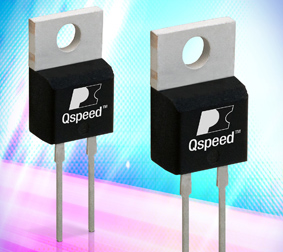
Power Integrations, the leader in high-voltage integrated circuits for energy-efficient power conversion, announced the immediate availability of the Qspeed family of advanced diodes. Qspeed diodes use a unique silicon-based process to combine an extremely low reverse recovery charge (QRR) with a very soft recovery waveform. Together, these features help designers optimize the efficiency and EMI performance of their power conversion circuits. Qspeed diodes are ideal for continuous conduction mode (CCM) boost power factor correction (PFC) circuits, and as output diodes for hard-switching applications. In PFC circuits, Qspeed diodes can provide an overall switching performance that is comparable to silicon-carbide (SiC) diodes at much lower cost.
When a silicon PN diode is reverse biased and turns off, the current rapidly falls to zero and then briefly flows backwards through the diode as the PN junction switches from conduction to blocking mode of operation. The product of time and negative current (i.e., the area under a plot of instantaneous current vs. time during commutation) is defined as reverse recovery charge, or QRR. The QRR flows to ground through other devices in the system and the energy is wasted as heat, reducing efficiency and possibly raising the temperature of costly associated components, such as MOSFETs. Qspeed diodes have the lowest QRR of any low-cost, silicon-based diode. They supplant ultrafast silicon diodes in PFC and rectifier applications targeting increased efficiency or temperature reduction, and they replace silicon-carbide diodes in applications with aggressive cost goals.
The reverse recovery waveform of a diode generates electrical noise (EMI) which must be filtered to low levels to prevent conduction to the AC mains, the power supply load, or radiation to nearby systems. Qspeed diodes have excellent softness – essentially a sinusoidal recovery waveform, which contains no high-frequency harmonics thus reducing conducted and radiated EMI emissions. This reduces the size, cost, weight, and complexity of a power supply’s EMI filter hardware, and reduces the prototyping and development cost associated with EMI suppression.
Qspeed diodes deliver industry-leading performance without the cost of exotic materials, enabling high-efficiency and low-cost designs. Qspeed 600 V diodes are available in three families. The X Series is optimized for cost-effective high efficiency at switching frequencies below 80 kHz, and the Q and H Series are designed for use above 80 kHz. The Q Series has the highest softness, giving the best EMI performance. The H Series has the lowest forward drop (VF) and QRR, providing the highest efficiency. In addition to the 600 V products, Qspeed 300 V diodes provide best-in-class switching for output rectification and audio applications.
Comments Stuart Hodge, product marketing manager at Power Integrations: “In addition to power factor correction circuits, Qspeed diodes are also well suited for use as output diodes – replacing Schottky diodes – particularly in high-current, high-voltage power supplies such as telecom and audio. In these applications, Qspeed diodes deliver a dramatic reduction in peak inverse voltage and the soft recovery often allows designers to completely remove snubber circuits, lowering design cost and complexity while increasing efficiency.”
Power Integrations acquired Qspeed Semiconductor in December 2010. All members of the Qspeed families of advanced diodes are now available from Power Integrations priced starting at $0.43 each for 1,000-piece quantities (LXA03T600; 3 A, 600 V). Full technical details, including an introductory video, datasheets, and application notes, are available now on the Power Integrations website at www.powerint.com/qspeed. An advanced diode selector tool that allows designers to easily choose the right diode for their specific application is also featured on the website.
www.powerint.com


